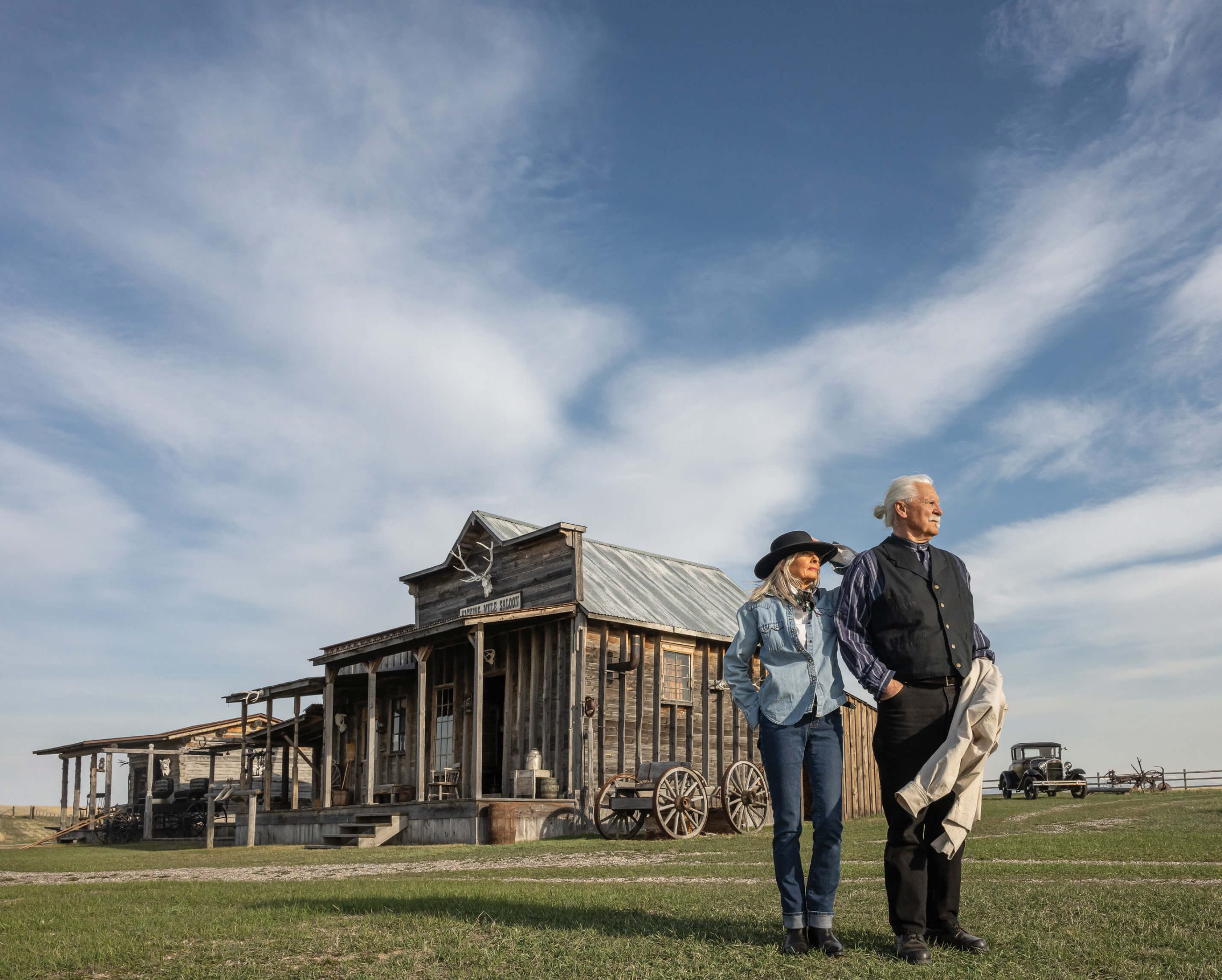
30 Apr Ghost Wolf Ranch
Rocky and Kat Hawkins give directions to Ghost Wolf Ranch not by street names but by landmarks and miles. The road to their home follows the meandering bends of Montana’s Jefferson River before it diverges on its path, and then you must watch the landscape to know where to turn: at the crest of a small hill; onto a dirt road that leads past grazing cattle, open fields, and gnarled cottonwood trees. Pass under a log arch crowned with elk antlers, bleached and brittle from the sun, and you’ve arrived.
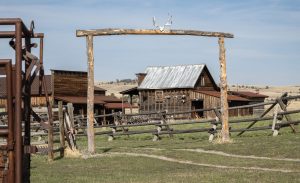
A second archway marked by deer antlers welcomes guests to No Horse. The couple has developed Ghost Wolf Ranch for more than 20 years, restoring the late-1800s buildings on site and adding a new house that fits with the Old West theme.
Driving through this threshold, you seem to slip a few hundred years into the past. The dirt road leads to a collection of rustic buildings that appear like a mirage of the Old West. Timbered barns and tin-roofed sheds gather like characters in a ghost town. And each one, in some way, reflects Rocky and Kat’s love for Western history — the grit, the romance, the weathered beauty of it all. They call their ghost town “No Horse.”
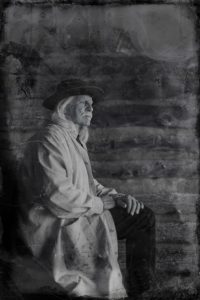
Rocky has been a professional artist since 1986. His work resists easy categorization and is often rooted in the American West while leaving much to the imagination.
Out here, life moves at nature’s pace. There are no telephone poles to interrupt the view, and the nearest grocery store is 50 miles away. Native grasses grow thigh-high by midsummer, and there’s no telling how tall the snowdrifts would be without putting up the snow fence. A small creek winds through the property, drawing in wildlife, and from their kitchen table, Kat points out two sandhill cranes, a moose, and a dove that flies by. She thinks the cranes may be the same pair from last summer.
“We love the stillness here,” Rocky says.
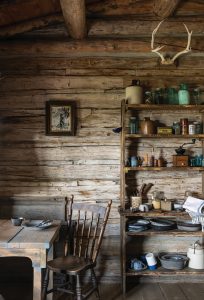
The single-room cabin, with hand-hewn walls and dovetail corners, was most likely built on the property in the 1860s by Dutch or German immigrants.
That stillness provides space to think and space to appreciate beauty, two things essential for creating art. And, as a professional artist since 1986, Rocky finds Ghost Wolf Ranch his ideal setting for creating paintings that reflect a sense of mystery.

The couple relocated the cabin and decorated it with period-appropriate items they have collected over the years from participating in Western rendezvous and reenactments.
The Hawkinses purchased the ranch, dotted with the remnants of a working homestead, in 2002. The property’s development represents more than two decades of work for the couple, who restored the late-1800s buildings and adapted others to meet their needs while retaining their rustic charm. To ensure an authentic representation, Kat and Rocky researched Western encampments from the late 1800s and visited Montana ghost towns such as Bannack and Virginia City, where they took notes and measurements of window frames and the width of the street.
To create No Horse, they salvaged two historic granary buildings from an old ranch located 1 mile away and turned them into a stage stop, mercantile, and saloon. And, with the help of some local rancher friends, they relocated an 1860s one-room cabin that was already on the property to create a trapper’s cabin. This homage to the Wild West is decorated with period-appropriate items, clothing, and furniture that they have collected over the decades.
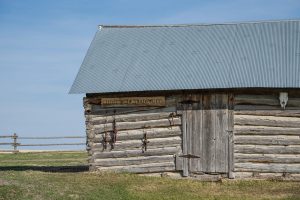
The Hawkinses love the patina that time and weather bring to architecture out West.
Across from this installation, the couple built a new home in 2012, working alongside a local contractor and his son over the course of a year. “Kat and I were sanding boards at 20 below,” Rocky recalls with a laugh. They designed their house to resemble a late-1800s hotel, complete with board-and-batten siding, tall double doors, and a false front that gives the appearance of two separate frontier-era businesses. Inside, textured stucco walls recall the seven years the couple spent in Santa Fe.
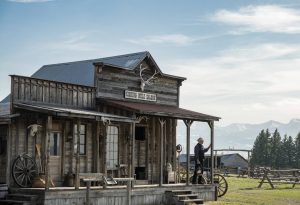
Kat and Rocky salvaged two historic granary buildings from an old ranch nearby, turning them into a stage stop, mercantile, and saloon.
Throughout their home, they embraced the Japanese philosophy of wabi-sabi, which celebrates the beauty of handmade objects and the character that comes with age and wear. “We didn’t want anything perfect,” Kat says. “We love the beauty of things that are perfectly imperfect.”
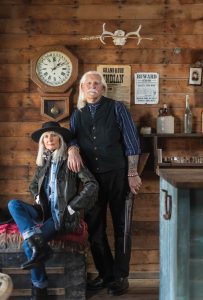
The saloon is meant to be gritty, Rocky explains, like real frontier saloons, which often had dirt floors and were sometimes erected overnight.
Much like their home, Rocky’s creative space has also evolved. For many years, he painted in a studio adjoining the garage where he stores his vintage car collection. However, Rocky’s most recently completed project on the ranch is a new studio, which he calls Green Door Studio 33. He fully restored a 100-year-old dairy and livestock barn, which was falling down, by renovating the foundation, adding a new roof reinforced with hand-built trusses, pouring concrete for the floors, and adding a loft, among other renovations. There are a few remaining touches to finish, but he has already started painting in the new space, and he plans to host workshops there soon.
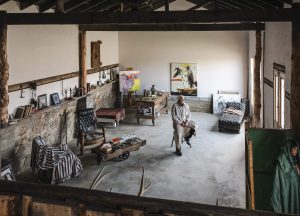
Rocky transformed a 100-year-old livestock barn into his new studio, preserving much of the building’s original charm. He is currently working on a series for his June show at Altamira Fine Art in Jackson, Wyoming.
In both studios, Rocky has been hard at work creating paintings for his upcoming show at Altamira Fine Art in Jackson, Wyoming, Into the West: Then & Now, from June 17 to July 1. The artist often paints in series, and for this show, he is reimagining the Old West in his distinct style.
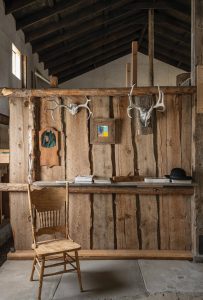
Throughout Ghost Wolf Ranch, antiques that the couple have found, collected, or were gifted find new life as weathered sculptures.
“My career obviously started out in Western art,” Rocky says. “But eventually, understanding Modernism and the Abstract artists — Motherwell, de Kooning, Rothko, Klein, Pollock — they gave me a whole new path to what could be ‘Western art.’”
Rocky’s work moves between pure abstraction, gestural figuration, and painterly realism. At times, he uses automatism, which is drawing or painting from the subconscious with no preconceived composition in mind. Some of his paintings will also incorporate mixed media. His education at Seattle’s Burnley School of Professional Art (now The Art Institute of Seattle) provided a well-rounded understanding of many different artistic fields, forming the groundwork of his future exploration.
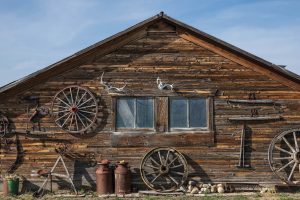
The artist fully restored the barn, renovating the foundation, adding a new roof reinforced with hand-built trusses, pouring concrete for the floors, and adding a loft, among other fixes.
Throughout his paintings, the eye discovers interesting little spaces: a streak of electric blue, a smudge of neon pink beneath the burnt umber. Details dissolve into layered washes and gestural brushstrokes. Cowboys emerge from fields of color — red, ochre, smoke-blue. Phantom-like horses trot through spectral landscapes. Horizontal bands of color suggest horizons. Faces may be obscured, bodies fragmented — yet the emotional resonance remains intact, evoking a sense of curiosity. The goal is not perfection, but feeling.
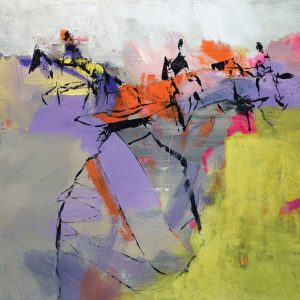
The Getaway | Acrylic on Canvas | 36 x 36 inches
“When you look at a mark that’s done with one or two movements — that’s the kind of art I’m after,” Rocky says.
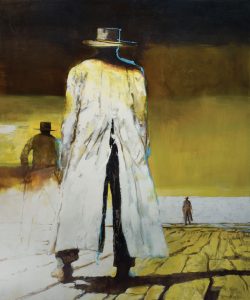
Did You Bring a Horse for Me | Acrylic on Canvas | 60 x 48 inches
That instinct — what to keep, what to erase, when to let go — forms the basis of his practice. Some figures he paints over again and again until they feel right. “See that cowboy right there?” Rocky says, pointing to a small figure in the lower third of Did You Bring a Horse for Me, a painting for the Altamira show inspired by a scene in the spaghetti Western “Once Upon a Time in the West.” “I’ve probably painted him 20 times.”
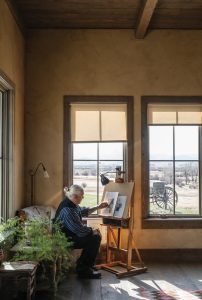
Rocky takes advantage of the natural light to sketch a quick drawing of a covered wagon, while a wagon’s skeletal remains casts shadows on the ground outside.
Even when mistakes are made — or perhaps especially then — they become foundational. There’s no overplanning — just a dialogue between artist and canvas, between the conscious and subconscious.
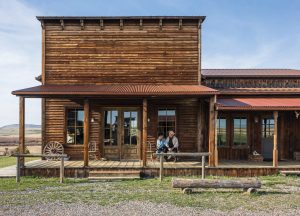
Kat and Rocky designed and built their home to resemble a late-1800s hotel; the false front gives the appearance of two separate frontier-era businesses.
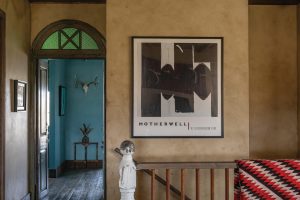
The character of their home reflects an appreciation for handmade details, including an antique door with a stained-glass transom window.
“We don’t have to know everything,” Rocky says. “Some of the unknown — the mystery — is what provides the entertainment. If you’re given the whole picture, you’re just processing. But if there’s mystery, your imagination takes over.”
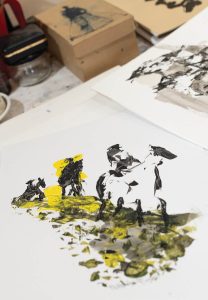
One of Rocky’s many sketches demonstrates the artist’s propensity for the unknown, sparking a sense of curiosity in viewers.
At Ghost Wolf Ranch, mystery isn’t just a theme in Rocky’s art — the land holds its own untold stories, hinted at in the silhouettes of old farm buildings. There’s no symmetry here, no clean edges. Only layers of texture, time, and creativity. Rocky and Kat have shaped the ranch board by board, creating a place where the line between life and art dissolves.
The ranch is their way of living in harmony with the West, with nature, and with the creative spirit. And like the best works of art, it invites us not just to see, but to think and feel — to step inside the mystery of the Old West and stay awhile.
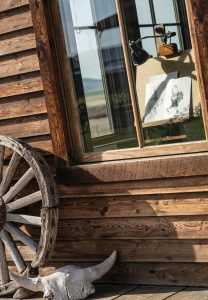
Ghost Wolf Ranch stands as a living tribute to the Old West — a place where history, art, and nature converge.





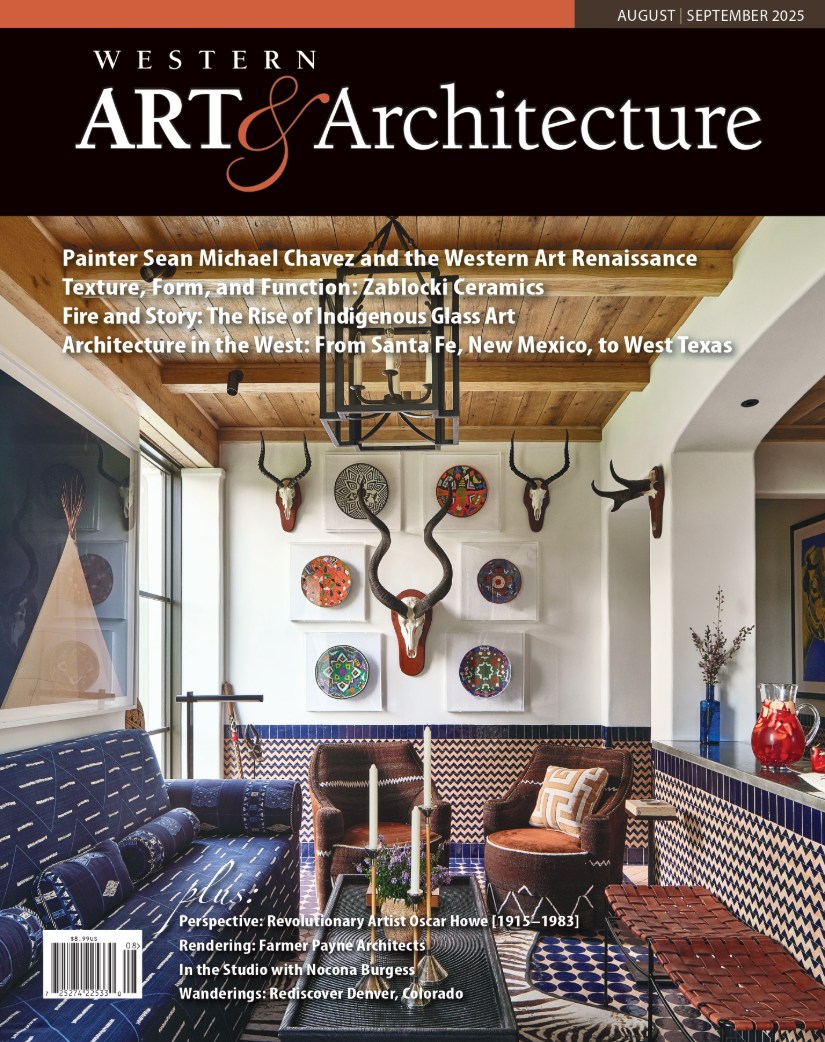
No Comments